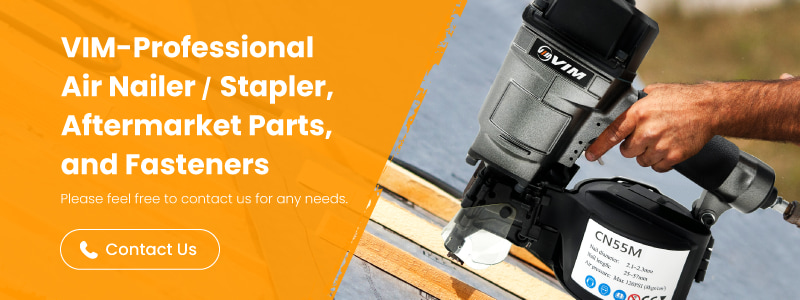3 Essential Tips You Absolutely Can’t Miss When Choosing Plastic Staplers
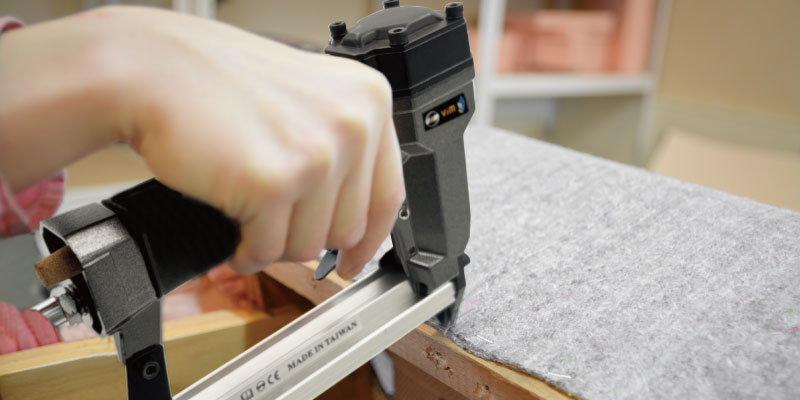
When it comes to choosing the right plastic stapler, several critical factors can ensure you're using the most suitable tool for your application. Whether you're working with lightweight materials like upholstery or handling more robust tasks such as construction or tire splicing, knowing the differences between models like the 81P, 82P, and 83P is essential. This guide explores considerations like staple size compatibility, magazine capacity, and operating pressure to help you make an informed decision.
What is a Plastic Stapler?
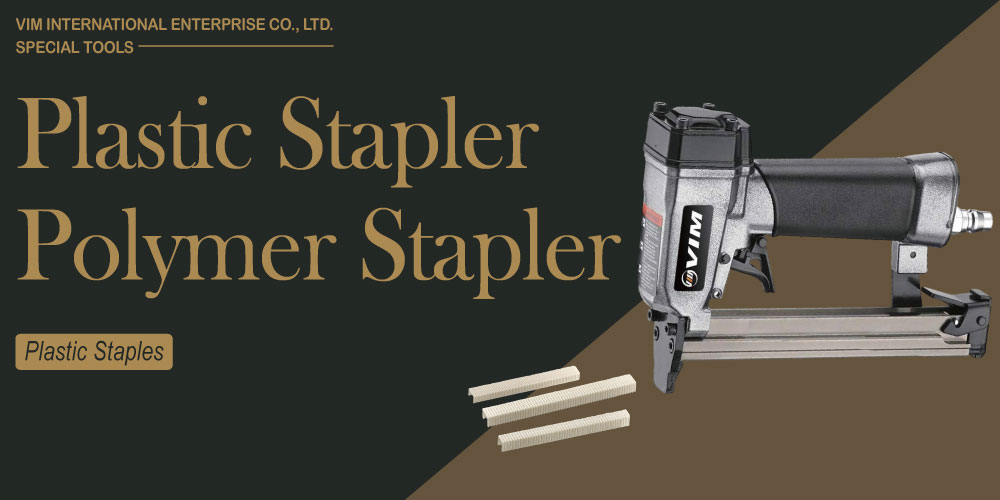 Plastic staplers, such as Vim’s 81P, 82P, and 83P, are mainly used in industries that require efficient and damage-free fastening of plastic materials. Their primary applications include packaging, where plastic sheets need to be secured without tearing or leaving residue, and construction, especially for securing insulation and protective coverings. These staplers are also utilized in furniture production and in marine industries, where plastic fastenings are essential. They are designed to offer durable and precise fastening solutions without damaging sensitive materials.
Plastic staplers, such as Vim’s 81P, 82P, and 83P, are mainly used in industries that require efficient and damage-free fastening of plastic materials. Their primary applications include packaging, where plastic sheets need to be secured without tearing or leaving residue, and construction, especially for securing insulation and protective coverings. These staplers are also utilized in furniture production and in marine industries, where plastic fastenings are essential. They are designed to offer durable and precise fastening solutions without damaging sensitive materials.
Applications of the Plastic Stapler
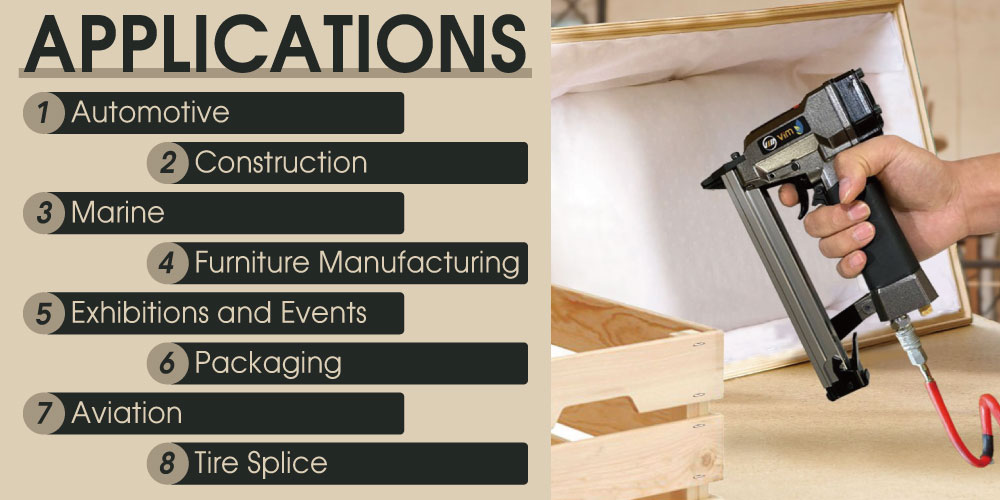 Plastic Staplers are perfect for boat construction, timber wrapping/tagging, and other applications where the use of metal staples would be unsuitable or potentially damaging.
Plastic Staplers are perfect for boat construction, timber wrapping/tagging, and other applications where the use of metal staples would be unsuitable or potentially damaging.
- Automotive: Used in assembling and repairing plastic components.
- Construction: Securing insulation, vapor barriers, and roofing materials.
- Marine: Attaching protective covers for boats to prevent water damage.
- Furniture Manufacturing: Non-corrosive fastening for upholstery and assembling wooden frames.
- Exhibitions and Events: Installing temporary structures with plastic sheeting.
- Packaging: Sealing plastic wraps and securing heavy-duty packaging.
- Aviation: Fastening lightweight plastic parts without metal interference.
- Tire Splice: Securing materials for tire splicing and restoration.
Advantages of Plastic Stapler
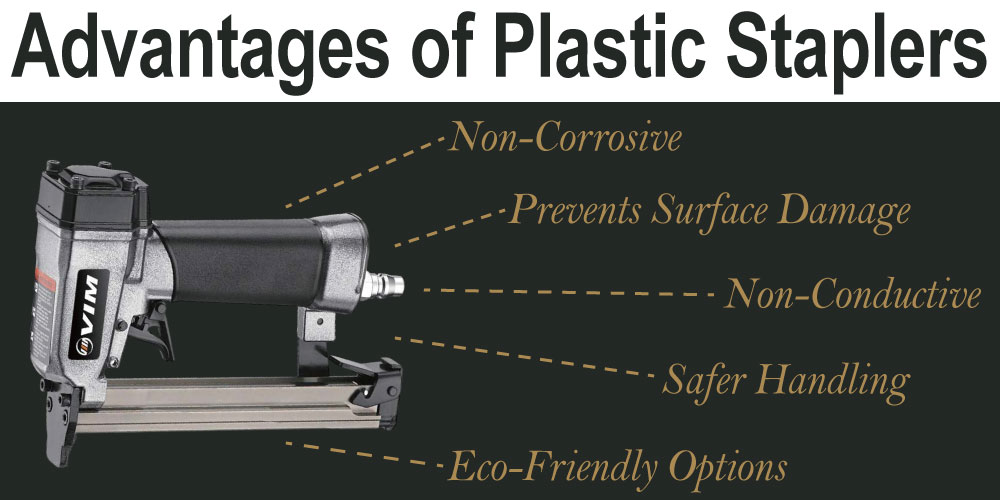
- Non-Corrosive: Perfect for humid or outdoor environments, as plastic staples won’t rust.
- Prevents Surface Damage: Ideal for delicate materials, avoiding scratches or dents.
- Non-Conductive: Safe to use around electrical components, reducing the risk of short circuits.
- Safer Handling: The reduced sharpness of plastic staples minimizes the risk of accidental injuries.
- Eco-Friendly Options: Some plastic staples can be made from recyclable materials, contributing to more sustainable practices.
Differences between 81P, 82P, and 83P Plastic Staplers
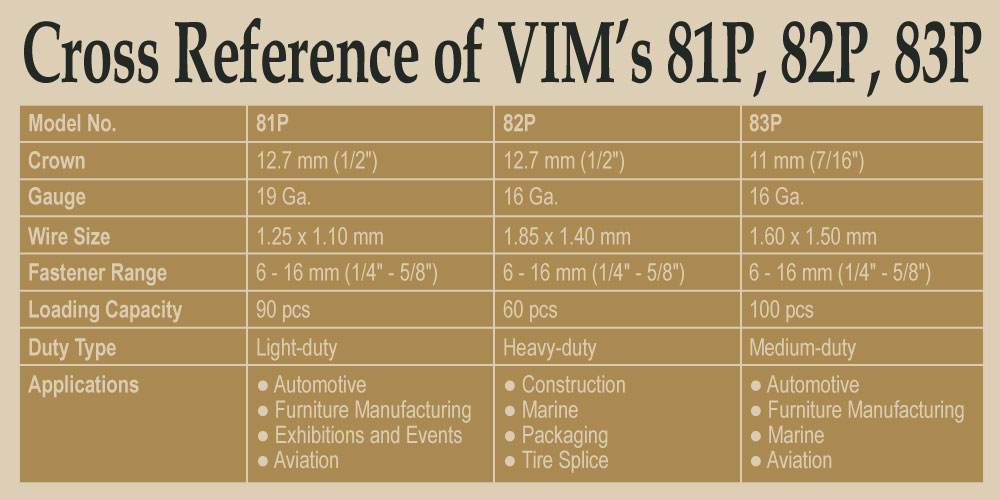 Based on the technical details of 81P, 82P, and 83P staplers, we can distribute the applications as follows:
Based on the technical details of 81P, 82P, and 83P staplers, we can distribute the applications as follows:
81P: Light-duty, 19-gauge but wider crown
Best for lightweight applications, using 19-gauge staples, ideal for precise, lighter tasks like upholstery and delicate material fastening.
- Automotive: Suitable for assembling small, lightweight plastic components where minimal fastening power is needed.
- Furniture Manufacturing: Ideal for delicate upholstery tasks, offering a non-corrosive fastening solution for lighter materials.
- Exhibitions and Events: Can be used to install temporary plastic sheeting or banners due to its lighter-duty staples.
- Aviation: Best for fastening small, lightweight plastic parts without risking metal interference in sensitive equipment.
82P: Heavy-duty, 16-gauge with wider crown
Heavier-duty, using 16-gauge staples with a wider crown, suitable for more robust tasks like securing insulation and other construction applications.
- Construction: Suitable for securing insulation, vapor barriers, and other mid-weight construction materials.
- Marine: Well-suited for fastening protective boat covers to prevent water damage, especially when more robust staples are needed.
- Packaging: Ideal for sealing heavy-duty packaging materials or securing plastic wraps where stronger holding power is necessary.
- Tire Splice: Provides the strength needed for securing materials in tire splicing and restoration.
83P: Medium-duty, 16-gauge with narrower crown
Positioned between the two, the 83P uses 16-gauge staples like the 82P, but with a narrower crown and a slightly different application range, making it useful for medium-duty, making it versatile for medium-duty applications that require both precision and holding power.
- Automotive: Also suitable for assembling plastic components, especially where more compact staples are needed.
- Furniture Manufacturing: Can be used in assembling wooden frames and securing upholstery where a slightly narrower crown is preferable.
- Marine: Suitable for tasks similar to the 82P, such as attaching protective covers for boats, but with narrower staples for a more precise finish.
- Aviation: Like the 81P, it is ideal for fastening lightweight plastic parts but offers a bit more strength while still avoiding metal interference.
Cross Reference of VIM’s 81P, 82P, 83P
| Model No. | 81P | 82P | 83P |
|---|---|---|---|
| Crown | 12.7 mm (1/2”) | 12.7 mm (1/2”) | 11 mm (7/16”) |
| Gauge | 19 Ga. | 16 Ga. | 16 Ga. |
| Wire Size | 1.25 x 1.10 mm | 1.85 x 1.40 mm | 1.60 x 1.50 mm |
| Fastener Range | 6 - 16 mm (1/4" - 5/8") | 6 - 16 mm (1/4" - 5/8") | 6 - 16 mm (1/4" - 5/8") |
| Loading Capacity | 90 pcs | 60 pcs | 100 pcs |
| Duty Type | Light-duty | Heavy-duty | Medium-duty |
| Applications | ● Automotive ● Furniture ● Manufacturing ● Exhibitions and Events ● Aviation |
● Construction ● Marine ● Packaging ● Tire Splice |
● Automotive ● Furniture ● Manufacturing ● Marine ● Aviation |
Considerations for Choosing the Right Plastic Stapler
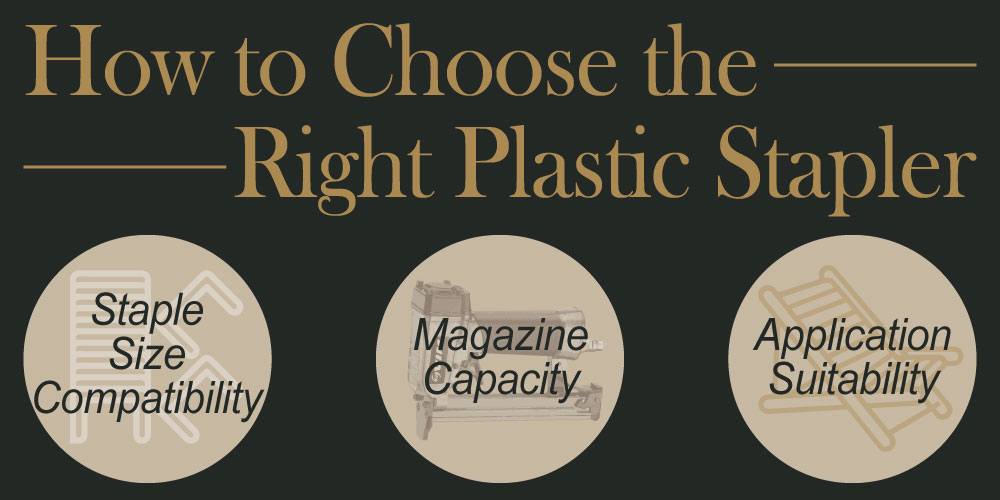 When selecting a plastic stapler, it’s crucial to evaluate key factors to ensure it matches your specific application needs:
When selecting a plastic stapler, it’s crucial to evaluate key factors to ensure it matches your specific application needs:
1. Staple Size Compatibility
Different stapler models, such as the 81P, 82P, and 83P, are designed to handle various staple gauges and crown widths. The 81P is suited for light-duty tasks using 19-gauge staples, while the 82P and 83P work with 16-gauge staples, with the 83P offering a narrower crown for more precise work.
2. Magazine Capacity
The loading capacity affects efficiency, especially in high-volume tasks. The 83P has the highest magazine capacity at 100 staples, making it suitable for medium-duty jobs that require less frequent reloading. The 81P and 82P have capacities of 90 and 60 staples, respectively.
3. Application Suitability
The intended use of the stapler should guide your choice. For light-duty applications such as upholstery, the 81P is ideal. For heavy-duty tasks like construction and tire splicing, the 82P is a better fit due to its robust design. The 83P, with its narrower crown, excels in medium-duty applications such as automotive assembly and furniture manufacturing, where both precision and holding power are required.
Conclusion
Selecting the ideal plastic stapler hinges on understanding the specific demands of your project. From light-duty tasks requiring precise fastening with the 81P, to the more robust applications handled by the 82P, or the versatile 83P that strikes a balance between precision and power, choosing the right stapler can significantly improve efficiency and performance. By considering factors such as staple size, magazine capacity, and operating pressure, you’ll be well-equipped to meet your application’s requirements.
VIM’s plastic stapler shares a similar design with Omer’s models. We also offer aftermarket repair parts compatible with Omer 81P, 82P, and 83P, ensuring continuous performance and reliable maintenance solutions.
Looking for a reliable plastic stapler to enhance your project's performance? Check out VIM’s plastic stapler solutions, designed with compatibility to Omer models. Whether you're in need of a new stapler or aftermarket repair parts for Omer 81P, 82P, or 83P, we’ve got you covered. Contact us today to find the perfect stapler for your needs and ensure seamless project execution with our top-notch support and products.
Article Classification
Recent Articles
- The All-in-One Reference for 4 Firing Modes in Pneumatic Tools
- The Ultimate Guide to Pin Nailers: How to Pick the Best One for Any Job
- What Is Decorative Nailer? Know Every Unique Difference About It
- 4 Reasons You Need Mattress Stapler for Professional Mattress Production
- Know the Mattress Stapler: 5 Unbeatable Advantages for Furniture

